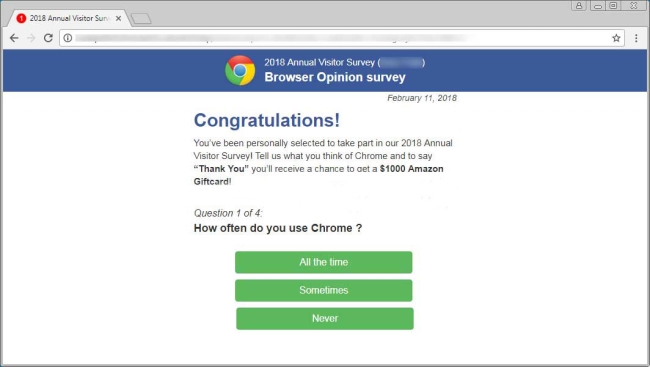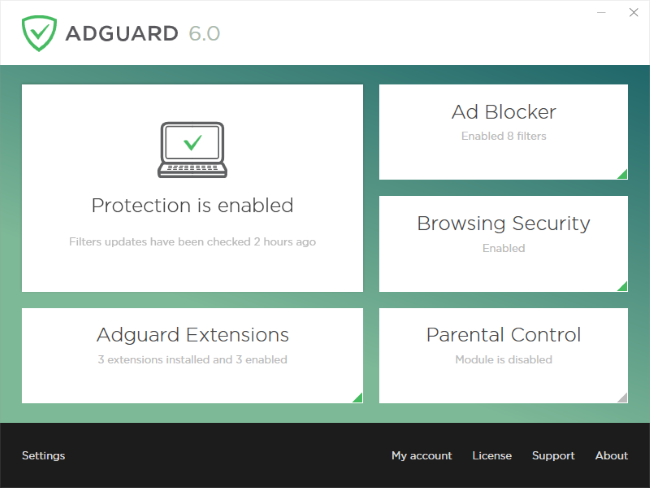What is “2018 Annual Visitor Survey”?
“2018 Annual Visitor Survey” is a scam site that may pop up on your browser when you click on links. The emergence of redirects is caused by adware that often gets on a computer with “bundling”. Bundling is a deceptive distribution method when the adware is automatically installed along with free programs without user’s consent. Therefore, to stop annoying redirects to “2018 Annual Visitor Survey”, you need to remove the “program-initiator”. Here you will find both automatic and manual methods about “2018 Annual Visitor Survey” removal. Just follow the instructions, described below.

How to remove “2018 Annual Visitor Survey” pop-up from your computer?
It scans your computer and detects various threats like “2018 Annual Visitor Survey” pop-up, then removes it with all of the related malicious files, folders and registry keys. After deep scanning of your system, it will easily find and delete “2018 Annual Visitor Survey” pop-up. Use this removal tool to get rid of “2018 Annual Visitor Survey” pop-up for FREE.

Norton 360 Antimalware – this program will help you to get rid of “2018 Annual Visitor Survey” pop-up. It can find a malicious program that is corrupting your system and clean up junk files after removal.
Solution for Mac users:
CleanMyMac
Combo Cleaner
How to remove “2018 Annual Visitor Survey” pop-up manually
Step 1: Remove “2018 Annual Visitor Survey” pop-up from Control Panel
In order to get rid of “2018 Annual Visitor Survey” pop-up, the first thing you need to do is to uninstall malicious program from your computer. When removing “2018 Annual Visitor Survey” pop-up, try to find suspicious recently installed programs and delete them too, as it’s pretty common that any malware comes with some other unwanted programs.
Windows XP:
- Select Start.
- Control Panel.
- Then choose Add or Remove Programs.
- Search for program related to “2018 Annual Visitor Survey” pop-up.
- Click Uninstall.
Windows 7/Windows Vista:
- Select Start.
- Then Control Panel.
- Choose Uninstall a Program.
- Find program related to “2018 Annual Visitor Survey” pop-up and choose Uninstall.
Windows 8/Windows 8.1:
- Open the Menu.
- Select Search.
- After that choose Apps.
- Next Control Panel.
- Then as in Windows 7, click Uninstall a Program under Programs.
- Find program related to “2018 Annual Visitor Survey” pop-up, select it and choose Uninstall.
Windows 10:
- Click on the Start button (or press the Windows key) to open the Start menu, then select Settings at the top.
- Choose App & features on the left menu.
- On the right side, find program related to “2018 Annual Visitor Survey” pop-up and select it, then click on the Uninstall button.
- Click on Uninstall to confirm.
Mac OSX:
- Launch Finder
- Select Applications in the Finder sidebar.
- If you see recently installed suspicious application that might be related to “2018 Annual Visitor Survey” pop-up, double-click it and follow instructions
- Drag unwanted application from the Applications folder to the Trash (located on the right side of the Dock)
Note: If you can’t find required program, sort programs by date in Control panel and search for suspicious recently installed programs.
Step 2: Remove “2018 Annual Visitor Survey” pop-up from browsers
Once you’ve uninstalled the application, remove “2018 Annual Visitor Survey” pop-up from your web browser. You need to search for recently-installed suspicious add-ons and extensions.
Google Chrome:
- Open Google Chrome
- Push Alt + F.
- Choose Tools.
- Select Extensions.
- Search for program related to “2018 Annual Visitor Survey” pop-up.
- Select the trash can icon to remove it.
Mozilla Firefox:
- Open Firefox.
- Push Shift + Ctrl + A.
- Select program related to “2018 Annual Visitor Survey” pop-up.
- Choose Disable or Remove option.
Internet Explorer:
- Open IE.
- Push Alt + T.
- Choose Manage Add-ons option.
- Click Toolbars and Extensions.
- Next select program related to Disable “2018 Annual Visitor Survey” pop-up.
- Choose More information link in the left-bottom corner.
- Click Remove button.
- If this button is grayed out – perform alternative steps.
Safari:
- Click Preferences from Safari menu
- Select Extensions.
- Find recently installed extension or other extensions that look suspicious.
- Click Uninstall button to remove it.
Step 3: Removing malicious link from your browser shortcuts
Sometimes even removing of malicious program from your computer and web browser can’t help. If you are still facing unknown webpage when you open your web browser, then you might have your browser shortcut changed. It’s a pretty common trick that performs most of the browser hijackers. They change your browser shortcut so that every time you open it you’ll see not your homepage, but some advertisement webpage. But this issue is quite simple to fix. The instruction stated below matches most of the browsers.
- Right-click on your browser shortcut, choose Properties.
- If you see a link to some website after .exe in the Target field, read on.
- Usually you are not able to delete a link from Target field, that’s why you need to click on the Open File Location button in this window.
- Once you’ve opened file location, select chrome.exe/firefox.exe/iexplore.exe.
- Right-click on this file and choose Sent to option, then Desktop (create shortcut).
- New shortcut will have no additional redirection links.
- Delete old infected shortcut. If you got one in your taskbar, delete it from there too.
- Now you have new and clear shortcut without redirection to unknown websites.
Step 4: Resetting your browser search and homepage settings
To be sure that there is nothing left behind, we recommend you to reset your browser. It will restore your browser settings to default.
Reset browser settings in Google Chrome:
- Click the Chrome menu (3 bar button) in the top right corner.
- Choose Settings.
- Click Show advanced settings.
- Go to Reset browser settings section.
- Click Reset browser settings.
- In the dialog that appears, click Reset.
Reset browser settings in Mozilla Firefox:
- Open Mozilla Firefox.
- Go to Help.
- Go to Troubleshooting information.
- Click Reset Firefox… button.
Reset browser settings in Internet Explorer:
- Open Internet Explorer.
- Click on the cogwheel in the right upper corner.
- Click Internet options.
- Got to Advanced tab.
- Click Reset button.
- Put a tick near Delete personal settings checkbox.
- Click Reset button.
How to block malicious pop-ups in browsers

Adguard is a perfect application that will get rid your system of annoying ads, online tracking and will provide reliable protection from malware. The main advantage of Adguard is that you can easily block any types of ads whether legitimate they or not within your browser. Use it for FREE.
Adguard provides 14 days for trial use, to continue using the program, you will need to purchase the full version: $19.95 for a yearly subscription/ $49.95 for lifetime version. By clicking the button, you agree to EULA and Privacy Policy. Downloading will start automatically.
